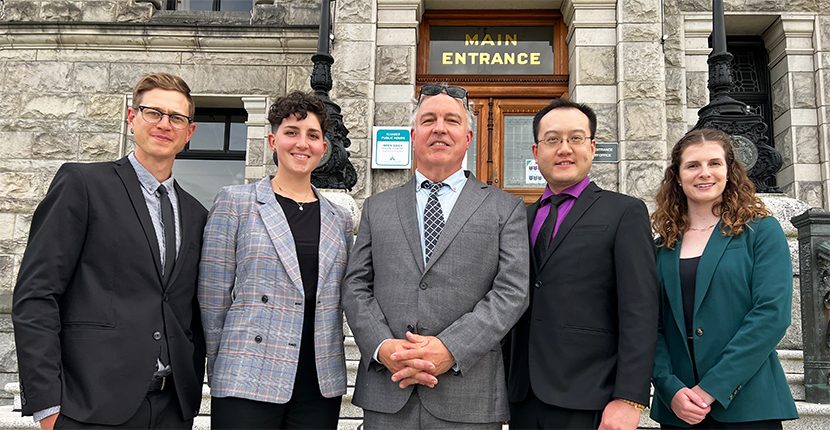
This summer, Tollefson Law is pleased to have welcomed three brilliant law students to join our team. Get to know our three law students in this Q&A as they introduce themselves, talk about what drew them to environmental law, what they hope for the future, and more!
Q1: How did you become interested in public interest environmental law?
Lydia: Coming from a non-legal background, law school had never been on my radar despite a long-term interest in social justice and environmental issues. I completed a B.Sc. with the intention of working in medicine, but I made a sharp turn to law after wildland firefighting in B.C. This seasonal work exposed me to other law students along with a plethora of environmental issues, such as the prevalence of old-growth logging and the impacts of worsening fires and floods on local communities. Because of this, I have been on a path towards public interest environmental law, particularly in the area of climate change.
Shannon: Prior to law school, I wanted to pursue conservation science research, with a focus on marine ecology. I had some incredible research opportunities during that time which undoubtedly changed my life in many ways, including helping me to realize that I did not want to pursue conservation research long term after all. Environmental law allows me to continue using my science background while expanding into the broader socio-political context that conservation science sits within. It was never a question to me that I would focus on public interest environmental law given that my interests prior to law school were already aligned with it.
James: Before arriving at law school, much of my free time was spent engaged in political and environmental grassroots activism. There is astounding creativity, support, and progress in those movements, but the pathways to success can be limited. I wanted to understand the institutional side of these efforts and equip myself with the tools and knowledge necessary for change. Public interest environmental law seems to be the best way of marrying my personal beliefs and future goals. I now appreciate the immeasurable sum of energy being devoted to these legal issues, and I believe our collective contributions will be enough to correct for generations of environmental exploitation.
Q2: What are your aspirations for the future?
Lydia: I aspire to draft policies and litigate climate-based issues. Since Canadians have been alerted to the severe impacts of global warming, I believe the law can be used as a tool to afford change socially, economically and politically. After law school, I will be pursuing an LL.M. in Global Environment and Climate Change Law, so that I can establish a career assisting Canada and other states in addressing the current and impending challenges of sustainable development and climate change mitigation.
Shannon: In the future, I hope to have a job that allows me to support the work of communities as they fight to protect ecosystems and each other from oppressive systems of power. I aspire to build on the work of my mentors, as well as make my own original contributions to the causes I care about. I want to be a lifelong learner who grows more and more capable at advocating for disempowered humans and nature. I also aspire to grow a garden and have a dog to take on the many adventures I hope to have exploring British Columbia and beyond.
James: I hope that one day we no longer view ecological degradation as a necessary trade off with human development. There is a way to live harmoniously with the nonhuman world that Indigenous peoples past and present have practiced for millennia. If my work can contribute—in any small way—to this shift in mindset, I will know I’m on the right path. In the interim, I am going to keep learning and growing to better serve the causes and people I care about.
Q3: What is something that you are excited for regarding environmental law?
Lydia: Working at Tollefson Law exposed me to the exciting field of anti-SLAPP laws. Canadian SLAPPs (Strategic Lawsuits Against Public Participation) first arose in B.C. as a means to hinder environmental advocates. These laws are important for protecting members of society who become an unbeknownst threat to corporations, and I look forward to the upcoming decisions from the Supreme Court of Canada that will further clarify these laws’ significance in the environmental and public interest realm.
Shannon: I am excited about the effects of the Declaration on the Rights of Indigenous Peoples Act on resource development projects. We have only just seen the first government-to-government agreement that protects First Nations’ consent-based rights under DRIPA in light of a development proposal, but the implications of this practice on the future of resource development feels profound.
James: We are long overdue for a constitutionally recognized right to a stable climate and healthy environment. The La Rose case, despite its setback at the Federal Court, is representative of the law’s ability to change how we see ourselves and our government in respect to our environment. Big environmental changes are rare and hard won, but there are few causes as existentially important.
Q4: What’s something unique or unusual about you?
Lydia: I have an identical twin who is completing her masters at UVic in Neurophysiology. We have a habit of confusing people on campus but it is a great way to meet people! I love rock climbing, am a huge fan of dogs, and a self-proclaimed bird nerd.
Shannon: I’m a dual citizen of the U.S. and Canada. My family moved around the U.S. quite a bit during my childhood, but I moved to B.C. at the start of my undergrad and have been here ever since. I’m also an amateur musician and live for cycling adventures.
James: When I get bored I try to learn a new (often trivial) skill. Juggling, riding a unicycle, and reciting the alphabet backwards are in the repertoire, so the next challenge is probably the Rubik’s cube.
